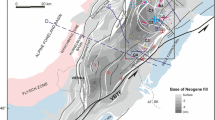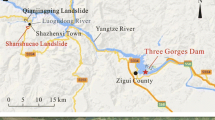Abstract
Su-Xi-Chang area and the city of Shanghai, located in the south of Yangtze Delta, China, has subsided due to groundwater overpumping. Because of the regional scale of the groundwater exploitation, cone of depression and land subsidence at present, Su-Xi-Chang area and Shanghai are treated as a single area for a land subsidence study, which could more clearly elaborate the relationships between the deformation features of hydrostratigraphic units and the different sites of the cone of depression. All hydrostratigraphic units in the study area were discussed throughout. Based on the field data, including data on compression of individual strata from groups of extensometers and groundwater levels from observation wells, the relationship between the deformation and the groundwater level was analyzed. The results indicate that the deformation features of the hydrogeologic units are greatly related to hydrogeologic properties and groundwater-level variations. An identical hydrogeologic unit may exhibit different deformation features in different locations such as along the periphery and in the center of the cone of depression. In addition, in the same location, a hydrogeologic unit also exhibits different features in different periods because of different groundwater level variations. The delay phenomenon of the sandy aquifer is not specific but occurs widely.
Résumé
La zone de Su-Xi Chang et de la ville de Shanghai, au sud du Delta de Yangtze en Chine, s’est effondrée du fait du sur-pompage de l’eau souterraine. A cause d’une exploitation de l’eau souterraine à l’échelle régionale, le cône de rabattement et l’effondrement du sol dans son état actuel, les zones de Su-Xi-Chang et de la ville de Shanghai sont traitées en une seule et même zone, qui pourrait montrer plus clairement les relations entre les aspects de la déformation des unités hydrostratigraphiques et les différents sites du cône de rabattement. Toutes les unités hydrostratigraphiques de la zone d’étude ont été traitées. Sur la base des données de terrain, et notamment les données de compression d’unités stratigraphiques individuelles provenant de groupes d’extensomètres et de niveaux piézométriques de puits d’observation, la relation entre la déformation et le niveau de l’eau a été analysée. Les résultats indiquent que les aspects de la déformation des unités hydrogéologiques sont fortement reliés aux propriétés hydrogéologiques et aux variations du niveau de l’eau. Une même unité hydrogéologique identique peut montrer différentes sortes de déformation selon la localisation, comme par exemple aux abords de la périphérie et au centre du cône de rabattement. De plus, au même endroit, une unité hydrogéologique peut montrer des comportements différents dans le temps du fait des variations du niveau de l’eau souterraine. Le phénomène de retard de l’aquifère sableux n’est pas spécifique bien qu’il existe largement dans la zone.
Resumen
El área de Su-Xi-Chang y la Ciudad de Shanghai, situadas al sur del Delta del Yangtze, China, han sufrido subsidencia debido a la sobreexplotación de las aguas subterráneas. Debido a la escala regional de la explotación de aguas subterráneas, el cono de depresión y la subsidencia del terreno actuales, el área de Su-Xi-Chang y la Ciudad de Shanghai se tratan como un área simple para el estudio de la subsidencia del terreno, que pueda elaborar más claramente las relaciones entre las características de las deformaciones de las unidades hidroestratigráficas y los diferentes lugares del cono de depresión. Todas las unidades hidroestratigráficas en el área de estudio fueron han sido discutidas completamente. Basándose en datos de campo, incluyendo datos de compresión de estratos individuales medidos por medio de grupos de extensómetros y niveles de agua subterránea tomados en puntos de observación, se analizó la relación entre la deformación y el nivel de agua subterránea. Los resultados indican que las características de la deformación de las unidades hidrogeológicas están relacionadas en gran medida con las propiedades hidrogeológicas y las variaciones del nivel de agua subterránea. Una unidad hidrogeológica idéntica puede tener diferentes deformaciones en diferentes sitios, como a lo largo de la periferia y en el centro del cono de depresión. Además, en el mismo sitio, una unidad hidrogeológica puede también mostrar diferentes comportamientos en diferentes periodos debido a las diferentes variaciones de los niveles de agua subterránea. El fenómeno de retraso del acuífero arenoso no es específico pero está generalizado.


















Similar content being viewed by others
Reference
Adrian OG, Rudolph LD, Cherry AJ (1999) Analysis of long-term land subsidence near Mexico City: field investigations and predictive modeling. Water Resour Res 35(11):3327–3341
Bergado DT, Nutalaya P, Balasubramaniam AS, Apaipong W, Chang CC, Khaw LG (1987) Causes, effects and predictions of land subsidence in AIT Campus, Chao Phraya Plain, Bangkok, Thailand. Bull Assoc Eng Geol 25(1):57–81
Carbognin L, Cecconi G, Ardone A (2000) Interventions to safeguard the environment of the Venice Lagoon (Italy) against the effects of land elevation loss. In: Proc. 6th Int. Symp. Land Subsidence, vol 1, Ravenna, Italy, September 2000, pp 309–324
Chen CX, Pei SP (2001) Numerical simulation of land subsidence due to groundwater withdrawal and its prevention countermeasure: an example of Suzhou, Jiangsu, China (in Chinese). China University of Geosciences Press, Wuhan, China, 86 pp
Gabrysch RK, Neighbors RJ (2000) Land-surface subsidence and its control in the Houston–Galveston region, Texas, 1906–1995. In: Proc. 6th Int. Symp. Land Subsidence, vol 2, Ravenna, Italy, September 2000, pp 81–92
Gu XY, Ran QQ (2000) A 3-D coupled model with consideration of rheological properties, Land Subsidence, vol. 2, Proc. of the 6th Int. Symp. Land Subsidence, Ravenna, Italy, September 2000, pp 355–365
Gu XY, Deng W, Xu DN, Liu Y (1993) Computation of land subsidence in Shanghai with secondary consolidation effect. In: Cheng YK, Yuan JX (eds) Proc. of the 1st Int. Conf. on Soft Soil Engineering, Guangzhou, China, 1993
LEHGGS (Laboratory of Engineering and Hydrological Geology and Geophysical Survey), GCSER (Geological center of Shanghai Economic Region) (1989) Study on the Quaternary geology, hydrogeology, engineering geology and mathematical model of land subsidence of Yangtze Delta of Shanghai (in Chinese). LEHGGS, Liege, Belgium and GCSER, Shanghai
Li QF, Fang Z, Wang HM (2000) Calculation and prediction of model of extractive groundwater in Shanghai (in Chinese). Shanghai Geol 13(2):36–43
Liu Y (2001) Land subsidence research approaches and advent problems (in Chinese). Earth Sci Front 8(2):273–278
NCCGS (Nanjing Center, China Geological Survey), Geological Survey of Jiangsu Province, SIGS(Geological Survey of Shanghai), Geological Survey of Zhejiang Province (2003) Investigation and estimation on groundwater resources and geological disasters on Yangtze Delta (in Chinese). China Geological Survey, Nanjing, pp 265
Shi XQ, Xue YQ, Wu JC, Zhang Y, Yu J, Zhu JQ (2006) Study on soil deformation properties of groundwater system in Changzhou area (in Chinese). Hydrogeol Eng Geol 33(3):1–6
Shi XQ, Xue YQ, Ye SJ, Wu JC, Zhang Y, Yu J (2007) Characterization of land subsidence induced by groundwater withdrawals in Su-Xi-Chang area, China. Environ Geol 52:27–40. DOI 10.1007/s00254-006-0446-3
Sun WS (2002) Investigation report on prevention and control of land subsidence in Yangtze Delta. In: Wei ZX, Li QF (eds) Proceedings of the National Symposium on Land Subsidence (in Chinese), Shanghai Institute of Geology Survey, Shanghai, pp 1–12
Wei ZX (2002) Stress and strain analysis of the fourth artesian aquifer in Shanghai (in Chinese). Hydrol Eng Geol 29(1):1–4
Wei ZX, Yang GF, Yu JY (2005) Stress-strain characteristics of the confined aquifer system and land subsidence controlling countermeasures in Shanghai (in Chinese). Chinese J Geol Hazard Control 16(1):5–8
Yamaguchi R (1969) Water level change in the deep well of the University of Tokyo. Bull Earthquake Res Inst No.47. http://wwwrcamnl.wr.usgs.gov/rgws/Unesco/PDF-Chapters/Chapter5.pdf
Ye SJ, Xue YQ, Zhang Y, Li QF, Wang HM (2005) Study on the deformation characteristics of soil layers in regional land subsidence model of Shanghai (in Chinese). Chinese J Geotech Eng 27(2):140–147
Yu J, Wu JQ, Wang XM, Yu Q (2004) Research on the correlative prediction model with a regional decomposition base of the land subsidence in the Suzhou-Wuxi-Changzhou area (in Chinese). Hydrogeol Eng Geol 4:92–95
Yu J, Wang XM, Wu JQ, Xie JB (2006) Characteristics of land subsidence and its remedial proposal in Suzhou-Wuxi-Changzhou area (in Chinese). Geol J China Univ 12(2):179–184
Zhang AG, Wei ZX (eds) (2005) Land subsidence in China (in Chinese). Shanghai Scientific and Technical Publishers, Shanghai
Zhang Y, Xue YQ, Li QF (2003) Current prominent subsidence layer and its deformation properties in Shanghai (in Chinese). Hydrogeol Eng Geol 30(5):6–11
Zhang Y, Xue YQ, Shi XQ, Song Z (2005) Study on nonlinear creep model for saturated sand (in Chinese). Rock Soil Mech 26(12):1869–1873
Acknowledgements
The authors would like to express appreciation to the three anonymous reviewers for their valuable comments and suggestions. We acknowledge Z.X. Wei of Institute of Geology Survey of Shanghai and J. Yu of Geological Survey of Jiangsu Province for their active collaboration. This report is financially supported by the National Nature Science Foundation of China grants No. 40335045, 40702037 and the National Science Foundation for Distinguished Youth Scholar No. 40725010.
Author information
Authors and Affiliations
Corresponding author
Rights and permissions
About this article
Cite this article
Shi, X., Xue, Y., Wu, J. et al. Characterization of regional land subsidence in Yangtze Delta, China: the example of Su-Xi-Chang area and the city of Shanghai. Hydrogeol J 16, 593–607 (2008). https://doi.org/10.1007/s10040-007-0237-2
Received:
Accepted:
Published:
Issue Date:
DOI: https://doi.org/10.1007/s10040-007-0237-2




